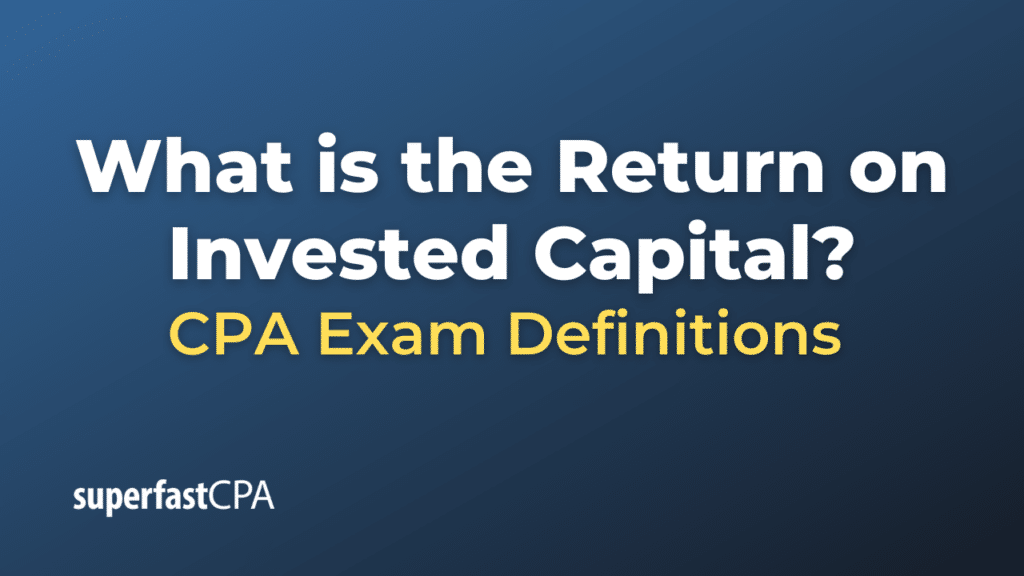Return on Invested Capital
Return on Invested Capital (ROIC) is a profitability ratio that measures the return a company generates on its total invested capital. Invested capital typically includes both equity and debt, so the ROIC gives an idea of how effectively a company uses the total money invested in its operations to produce profit. This makes ROIC a useful measure for evaluating the efficiency of a company’s capital allocation.
The formula for ROIC is:
ROIC = Net Operating Profit After Taxes (NOPAT) / Total Invested Capital
Where:
- Net Operating Profit After Taxes (NOPAT) is the operating profit of the company with corporate taxes subtracted. This represents the potential cash available to all investors (equity holders, debt holders, preferred stockholders, etc.) if the company had no debt.
- Total Invested Capital is the sum of the company’s equity and interest-bearing debt. It essentially represents all the capital that the company has sourced, either from shareholders, creditors, or other financing sources.
Interpreting ROIC:
- Comparative Measure: Like many financial ratios, ROIC is most useful when comparing it to other companies in the same industry, or to the company’s past ROIC values.
- Exceeding Cost of Capital: If a company’s ROIC exceeds its weighted average cost of capital (WACC), it indicates that the company is creating value for its investors. Conversely, if ROIC is below the WACC, the company might be destroying value.
- Operational Efficiency: A high ROIC can indicate that a company is efficient at turning its invested capital into profits.
- Investment Decisions : From an investor’s perspective, companies with a consistently high ROIC may be more attractive because they demonstrate a proven track record of effectively using capital to grow the business.
ROIC is especially favored in evaluations of companies where capital allocation decisions are crucial, such as in capital-intensive industries or when evaluating the efficiency of acquisitions and expansions.
Example of the Return on Invested Capital
Let’s illustrate the Return on Invested Capital (ROIC) with a fictional company, GHI Industries.
Company GHI Industries Financials for the Year:
- Operating Profit (EBIT): $400,000
- Tax Rate: 30%
- Shareholders’ Equity: $1,500,000
- Interest-bearing Debt: $1,000,000
Steps to calculate ROIC:
- Calculate Net Operating Profit After Taxes (NOPAT):
NOPAT = Operating Profit × (1−Tax Rate)
NOPAT = $400,000 x (1 – 0.30)
NOPAT = $400,000 x 0.70
NOPAT = $280,000
- Calculate Total Invested Capital:
Total Invested Capital = Shareholders’ Equity + Interest-bearing Debt
Total Invested Capital = $1,500,000 + $1,000,000
Total Invested Capital = $2,500,000
- Calculate ROIC:
ROIC = NOPAT / Total Invested Capital
ROIC = $280,000 / $2,500,000
ROIC = 0.112
When expressed as a percentage, GHI Industries’ ROIC is 11.2%.
Analysis:
This result means that for every dollar of invested capital in GHI Industries (including both equity and debt), the company generated a profit of $0.112 (or 11.2 cents) during the year.
To make this figure meaningful:
- An analyst might compare this 11.2% ROIC to GHI Industries’ weighted average cost of capital (WACC) to determine if the company is generating a return above its cost of capital.
- It would also be insightful to benchmark this ROIC against other companies in the same industry or to past ROIC values for GHI Industries.
- Additionally, other factors and qualitative information should be considered to get a complete picture of the company’s financial health and efficiency.
The ROIC ratio is a comprehensive way to assess how effectively a company uses its total capital to generate profit, encompassing both equity and debt.













